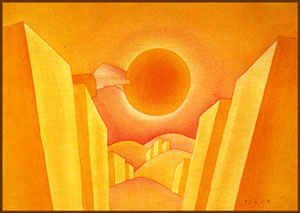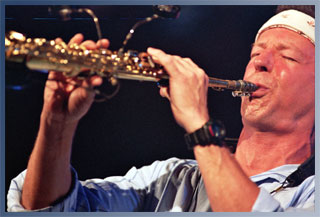

|
Soundclip:
|
| See Steve's Hand-Written Lead
Sheet |
|
Steve
Khan's
lead
sheet:  This type of tune bears the influence of early Weather Report and was always intended to serve as a vehicle for a wandering Bill Evans soprano sax improvisation over a static Fmaj7(9#4) sonority. The texture is supplied by Clifford Carter's lush Rhodes, Neil's fretless, that Paiste ride, and Café's spatial usage of percussion, and even his voice, here and there. The day we recorded the three pieces, this one was done first because I knew it would be the only one on which Bill; Neil; and Chris would appear. It was all done rather quickly and efficiently. Though we recorded everything at RPM Studios with engineer Kevin Halpin, we then took the tapes to Automated Sound to mix because, in the past, I had experienced some problems mixing at RPM, but I don't recall why. Kevin did a wonderful job to create the very spacey texture I was looking for, and this is not as simple as just slapping reverb on everything! Not unlike "Candles," this piece could easily function without the presence of a guitar. So, I had to be careful to include myself but not to allow the guitar to distract from the mood and the attitude of the tune which are firmly established at [I]. So, I carefully orchestrated my Martin MC-28 acoustic steel-string into that texture by lightly playing the top voice of each sonority in bars 1, 2 and 3, but in bar 4, the guitar plays the inner voice which moves chromatically upwards: A-B-C, while the D in the piano remains as the uppermost voice. This is repeated each time the [I] section appears. When Bill Evans' soprano enters at letter [A], the acoustic guitar doubles the melody with him. At [B], we arrive at the reason why Neil Jason and his fretless were essential. Here, just like in early Weather Report, a bass melody is doubled by the soprano sax. Obviously, this was done initially by Wayne Shorter and Miroslav Vitous. It now strikes me as so odd that this 'bridge' section, [B], is but 4 bars long. But, that's enough of a harmonic and textural release from all that surrounds it. At least I hope so! I think if I were to ever use this piece again, I would compose a 4th section, one which harmonically moves even further away from Fmaj7(9/6). It could certainly use that element of contrast. When you've played with certain musicians, and in a variety of contexts, it affords you the great luxury of having to explain too much about just what it is that you might be looking for on a piece such as this. With all the players present, but especially with Clifford Carter, there wasn't much that I had to say. The group Elements has "mined the fields" of one-chord major oriented improvisations, and done so beautifully, as well as any group ever has. So, having Clifford and Bill there made this easy. After we have arrived at the sax solo, letter [D], this dreamy section continues until Bill gives us a 'cue' and then we re-state [B2]. After this, we D.C. to the top of the tune again, and play all the way through [I] and [A], before taking the Coda which brings us to [D2] and brief electric guitar improvisation. This was played on my ESP Strat and recorded direct into the board. On my 'cue' we D.S. to [C] and after playing those 8 bars we take a Double Coda for a final 'vamp' at [E] and Fade over Fmaj7(9#4).  Without question, this piece, perhaps more than the others, was all about mood and attitude. However, to create those elements is no small feat. You need players who are sensitive to these textures and who have absolute confidence in knowing what to do, and just where to leave the space, to let the music breathe. This is, in no way, as simple as it might seem. To prove what I'm saying, you can easily print-out this lead sheet, gather some players together on these instruments(remember you do not need guitar!), and see what happens. Without question, this piece, perhaps more than the others, was all about mood and attitude. However, to create those elements is no small feat. You need players who are sensitive to these textures and who have absolute confidence in knowing what to do, and just where to leave the space, to let the music breathe. This is, in no way, as simple as it might seem. To prove what I'm saying, you can easily print-out this lead sheet, gather some players together on these instruments(remember you do not need guitar!), and see what happens.The title, "Warm Blue Town," was based upon my impressions after viewing the animation for the first time. I hadn't seem these visuals in ages, but I recall that there is a scene of a city with rich, cool blue hues. And, with the coming of light and heat, the city is transformed into a lustrous golden place. Hence, what was once just a "Blue Town" has become a "Warm Blue Town." Again, I want to thank George Braun for making this all happen, because it was such a great thrill for me. Recently, the visuals were transferred from tape to DVD and it brings back great memories to see these computerized images of Folon's work. How sad it is that he is no longer with us. But, the work he left behind will linger for generations to come.
[Photo of Bill Evans by: Jesús Ángel Martínez Laucírica]
|